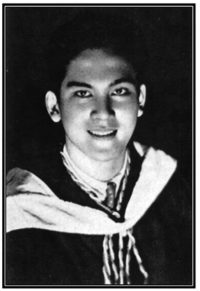An early alarm routed us out of bed. There were no planes overhead but the Japanese radio said that an American task force was attacking the Tokyo area, warning that the American shipboard planes were almost impossible to distinguish from Japanese fighters. I was anxious, for more news, and so I dressed quickly and hurried down. The streets were deserted except for air-raid wardens in the black-collared olive-drab uniforms of the neighborhood associations. It is forbidden to move under an air-raid but they let me pass without challenge. They shuffled their feet uncertainly and looked the other way. At the embassy the short-wave calmed our apprehensions. The carrier force was attacking airfields around Tokyo and not the capital itself.
The siren kept screaming throughout the morning. Alarm. Alert. Alarm. All clear. Alert. Alarm. The long drawn-out sigh of the alert, signifying the actual alarm was over. Then, hard upon its echo, once more the nervous surprised and breathless gasps of the alarm as one more wave of the carrier planes broke through.
I took advantage of a lull between alarms to keep a luncheon engagement with the Burmese ambassador. The automobile sped through empty streets. Sometimes a streetcar island held a group of four or five huddled uneasily together, clasping useless fire-fighting hoods and darting quick anxious looks at the sky.
Today a Domei dispatch reminded the Japanese that the carrier-borne planes were not the whole of their worries. “On April 25,” the article points out, “all the first-class diplomats of the Anti-Axis will assemble at San Francisco to devise a system of world security. This day happens to be the last day on which the Soviet Union can notify Japan of its abrogation of the neutrality pact upon one year’s notice. Unless abrogation is notified by this date, the pact will automatically continue to be in effect for another five years. Accordingly, the stand of the Soviet Union vis-a-vis Japan will be made more clear-cut at San Francisco than it was at Yalta.”
